Accounting Report on Recording and Analyzing Business Transactions
VerifiedAdded on 2022/12/29
|13
|2592
|39
Report
AI Summary
This report provides a comprehensive analysis of recording business transactions. It begins with an introduction defining business transactions and their importance, followed by an assessment that includes identifying decision-makers at Unilever and their need for accounting information, along with the advantages and disadvantages of accounting practices. The report then delves into practical application by computing journal entries for business transactions in January 2020, creating a general ledger for Pearce and Sons, and extracting a trial balance. Furthermore, it constructs an income statement for Airman Co. and explains the impact of COVID-19 on the company's financial performance. The report concludes by summarizing the key findings and emphasizing the significance of accounting in financial decision-making, systematic recording of financial transactions, and preparation of financial statements to assess business performance and financial position.
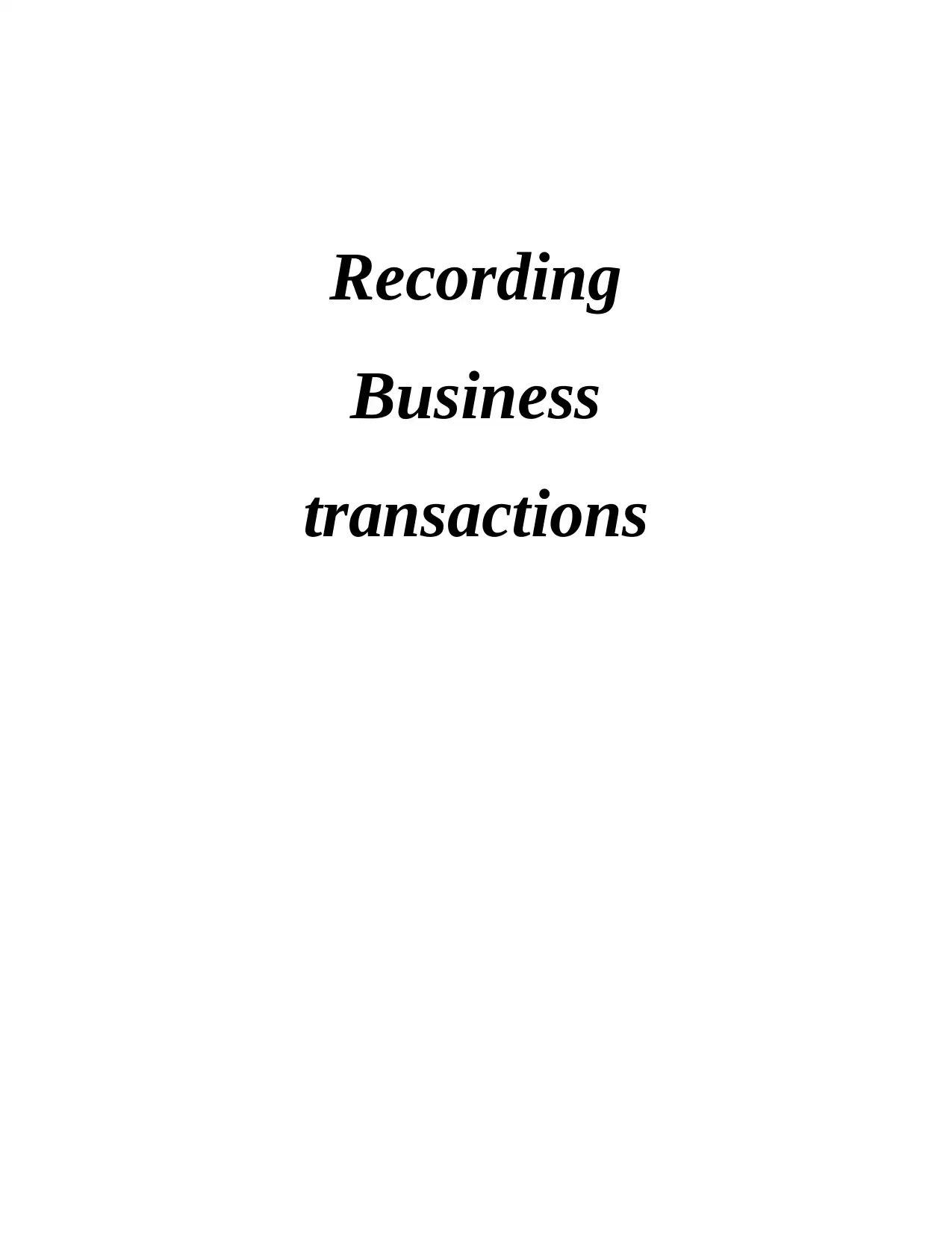
Recording
Business
transactions
Business
transactions
Paraphrase This Document
Need a fresh take? Get an instant paraphrase of this document with our AI Paraphraser
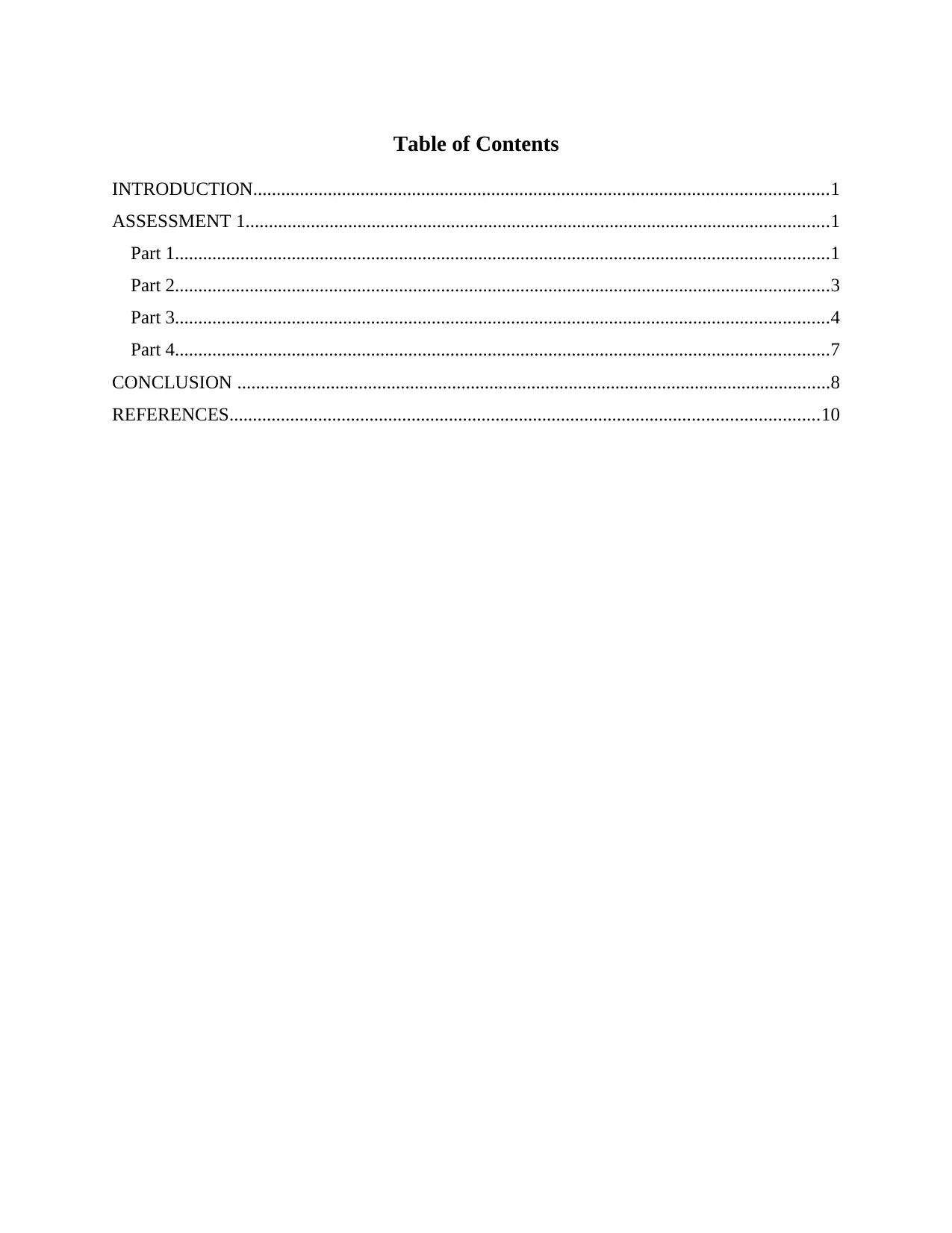
Table of Contents
INTRODUCTION...........................................................................................................................1
ASSESSMENT 1.............................................................................................................................1
Part 1............................................................................................................................................1
Part 2............................................................................................................................................3
Part 3............................................................................................................................................4
Part 4............................................................................................................................................7
CONCLUSION ...............................................................................................................................8
REFERENCES..............................................................................................................................10
INTRODUCTION...........................................................................................................................1
ASSESSMENT 1.............................................................................................................................1
Part 1............................................................................................................................................1
Part 2............................................................................................................................................3
Part 3............................................................................................................................................4
Part 4............................................................................................................................................7
CONCLUSION ...............................................................................................................................8
REFERENCES..............................................................................................................................10
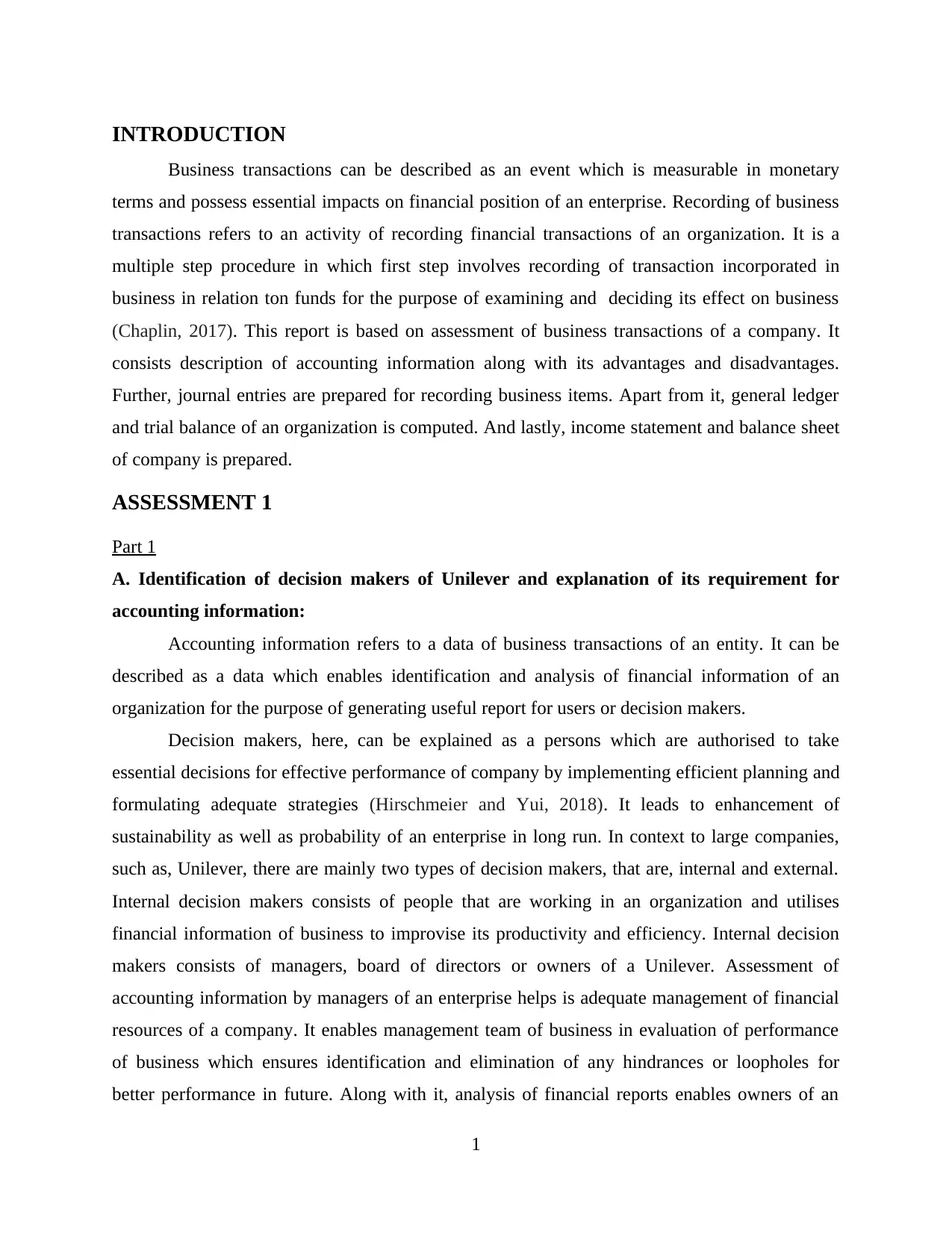
INTRODUCTION
Business transactions can be described as an event which is measurable in monetary
terms and possess essential impacts on financial position of an enterprise. Recording of business
transactions refers to an activity of recording financial transactions of an organization. It is a
multiple step procedure in which first step involves recording of transaction incorporated in
business in relation ton funds for the purpose of examining and deciding its effect on business
(Chaplin, 2017). This report is based on assessment of business transactions of a company. It
consists description of accounting information along with its advantages and disadvantages.
Further, journal entries are prepared for recording business items. Apart from it, general ledger
and trial balance of an organization is computed. And lastly, income statement and balance sheet
of company is prepared.
ASSESSMENT 1
Part 1
A. Identification of decision makers of Unilever and explanation of its requirement for
accounting information:
Accounting information refers to a data of business transactions of an entity. It can be
described as a data which enables identification and analysis of financial information of an
organization for the purpose of generating useful report for users or decision makers.
Decision makers, here, can be explained as a persons which are authorised to take
essential decisions for effective performance of company by implementing efficient planning and
formulating adequate strategies (Hirschmeier and Yui, 2018). It leads to enhancement of
sustainability as well as probability of an enterprise in long run. In context to large companies,
such as, Unilever, there are mainly two types of decision makers, that are, internal and external.
Internal decision makers consists of people that are working in an organization and utilises
financial information of business to improvise its productivity and efficiency. Internal decision
makers consists of managers, board of directors or owners of a Unilever. Assessment of
accounting information by managers of an enterprise helps is adequate management of financial
resources of a company. It enables management team of business in evaluation of performance
of business which ensures identification and elimination of any hindrances or loopholes for
better performance in future. Along with it, analysis of financial reports enables owners of an
1
Business transactions can be described as an event which is measurable in monetary
terms and possess essential impacts on financial position of an enterprise. Recording of business
transactions refers to an activity of recording financial transactions of an organization. It is a
multiple step procedure in which first step involves recording of transaction incorporated in
business in relation ton funds for the purpose of examining and deciding its effect on business
(Chaplin, 2017). This report is based on assessment of business transactions of a company. It
consists description of accounting information along with its advantages and disadvantages.
Further, journal entries are prepared for recording business items. Apart from it, general ledger
and trial balance of an organization is computed. And lastly, income statement and balance sheet
of company is prepared.
ASSESSMENT 1
Part 1
A. Identification of decision makers of Unilever and explanation of its requirement for
accounting information:
Accounting information refers to a data of business transactions of an entity. It can be
described as a data which enables identification and analysis of financial information of an
organization for the purpose of generating useful report for users or decision makers.
Decision makers, here, can be explained as a persons which are authorised to take
essential decisions for effective performance of company by implementing efficient planning and
formulating adequate strategies (Hirschmeier and Yui, 2018). It leads to enhancement of
sustainability as well as probability of an enterprise in long run. In context to large companies,
such as, Unilever, there are mainly two types of decision makers, that are, internal and external.
Internal decision makers consists of people that are working in an organization and utilises
financial information of business to improvise its productivity and efficiency. Internal decision
makers consists of managers, board of directors or owners of a Unilever. Assessment of
accounting information by managers of an enterprise helps is adequate management of financial
resources of a company. It enables management team of business in evaluation of performance
of business which ensures identification and elimination of any hindrances or loopholes for
better performance in future. Along with it, analysis of financial reports enables owners of an
1
⊘ This is a preview!⊘
Do you want full access?
Subscribe today to unlock all pages.

Trusted by 1+ million students worldwide
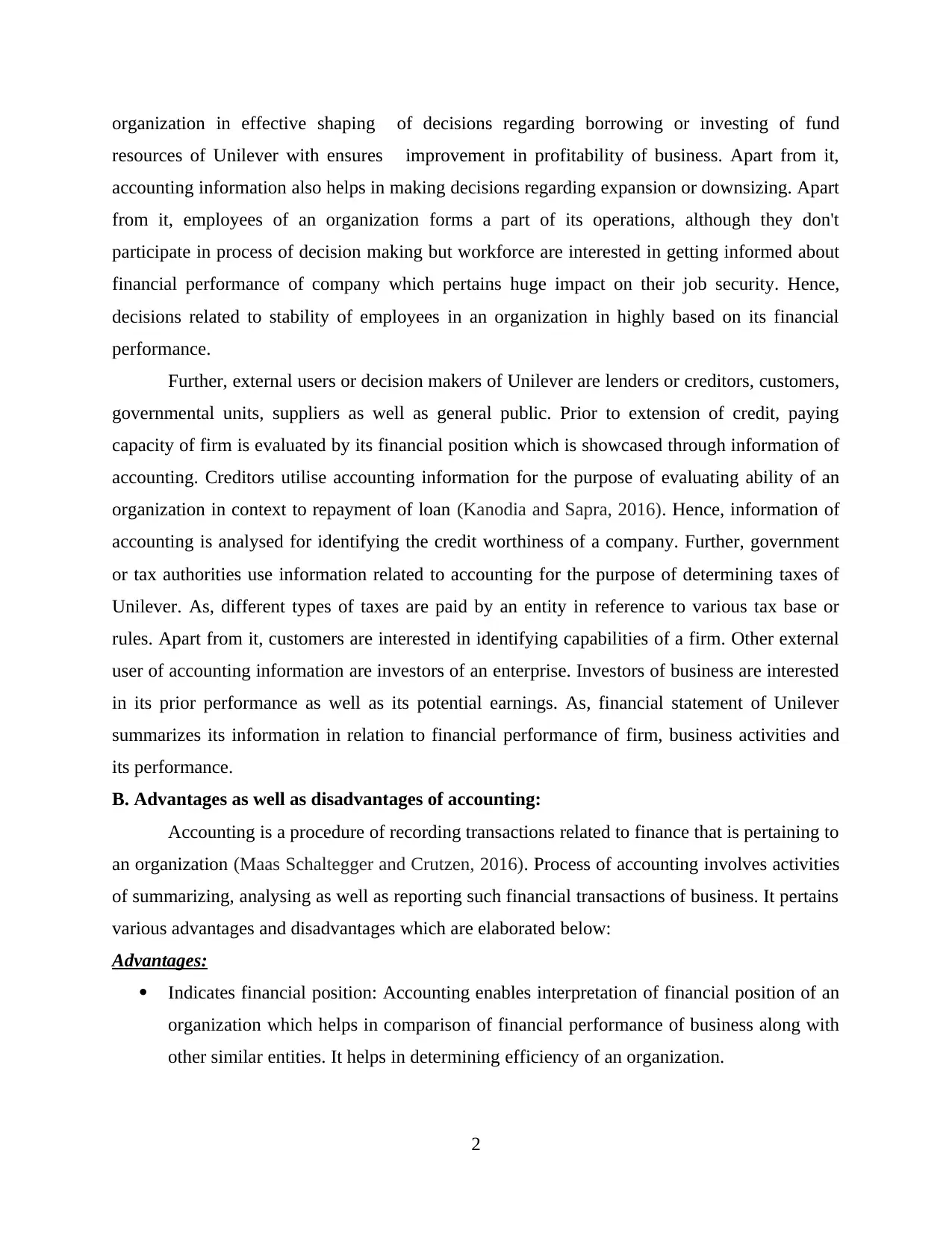
organization in effective shaping of decisions regarding borrowing or investing of fund
resources of Unilever with ensures improvement in profitability of business. Apart from it,
accounting information also helps in making decisions regarding expansion or downsizing. Apart
from it, employees of an organization forms a part of its operations, although they don't
participate in process of decision making but workforce are interested in getting informed about
financial performance of company which pertains huge impact on their job security. Hence,
decisions related to stability of employees in an organization in highly based on its financial
performance.
Further, external users or decision makers of Unilever are lenders or creditors, customers,
governmental units, suppliers as well as general public. Prior to extension of credit, paying
capacity of firm is evaluated by its financial position which is showcased through information of
accounting. Creditors utilise accounting information for the purpose of evaluating ability of an
organization in context to repayment of loan (Kanodia and Sapra, 2016). Hence, information of
accounting is analysed for identifying the credit worthiness of a company. Further, government
or tax authorities use information related to accounting for the purpose of determining taxes of
Unilever. As, different types of taxes are paid by an entity in reference to various tax base or
rules. Apart from it, customers are interested in identifying capabilities of a firm. Other external
user of accounting information are investors of an enterprise. Investors of business are interested
in its prior performance as well as its potential earnings. As, financial statement of Unilever
summarizes its information in relation to financial performance of firm, business activities and
its performance.
B. Advantages as well as disadvantages of accounting:
Accounting is a procedure of recording transactions related to finance that is pertaining to
an organization (Maas Schaltegger and Crutzen, 2016). Process of accounting involves activities
of summarizing, analysing as well as reporting such financial transactions of business. It pertains
various advantages and disadvantages which are elaborated below:
Advantages:
Indicates financial position: Accounting enables interpretation of financial position of an
organization which helps in comparison of financial performance of business along with
other similar entities. It helps in determining efficiency of an organization.
2
resources of Unilever with ensures improvement in profitability of business. Apart from it,
accounting information also helps in making decisions regarding expansion or downsizing. Apart
from it, employees of an organization forms a part of its operations, although they don't
participate in process of decision making but workforce are interested in getting informed about
financial performance of company which pertains huge impact on their job security. Hence,
decisions related to stability of employees in an organization in highly based on its financial
performance.
Further, external users or decision makers of Unilever are lenders or creditors, customers,
governmental units, suppliers as well as general public. Prior to extension of credit, paying
capacity of firm is evaluated by its financial position which is showcased through information of
accounting. Creditors utilise accounting information for the purpose of evaluating ability of an
organization in context to repayment of loan (Kanodia and Sapra, 2016). Hence, information of
accounting is analysed for identifying the credit worthiness of a company. Further, government
or tax authorities use information related to accounting for the purpose of determining taxes of
Unilever. As, different types of taxes are paid by an entity in reference to various tax base or
rules. Apart from it, customers are interested in identifying capabilities of a firm. Other external
user of accounting information are investors of an enterprise. Investors of business are interested
in its prior performance as well as its potential earnings. As, financial statement of Unilever
summarizes its information in relation to financial performance of firm, business activities and
its performance.
B. Advantages as well as disadvantages of accounting:
Accounting is a procedure of recording transactions related to finance that is pertaining to
an organization (Maas Schaltegger and Crutzen, 2016). Process of accounting involves activities
of summarizing, analysing as well as reporting such financial transactions of business. It pertains
various advantages and disadvantages which are elaborated below:
Advantages:
Indicates financial position: Accounting enables interpretation of financial position of an
organization which helps in comparison of financial performance of business along with
other similar entities. It helps in determining efficiency of an organization.
2
Paraphrase This Document
Need a fresh take? Get an instant paraphrase of this document with our AI Paraphraser
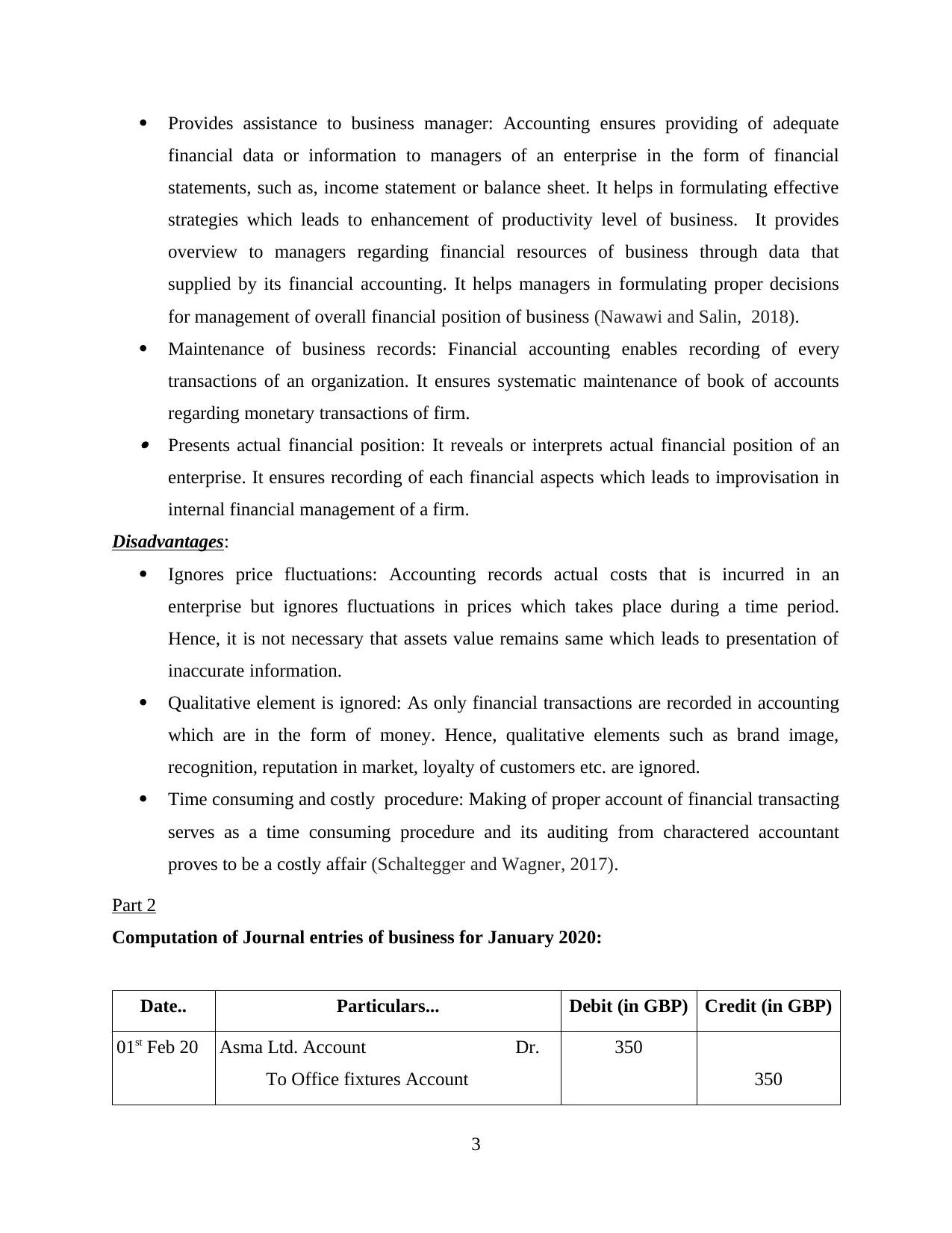
Provides assistance to business manager: Accounting ensures providing of adequate
financial data or information to managers of an enterprise in the form of financial
statements, such as, income statement or balance sheet. It helps in formulating effective
strategies which leads to enhancement of productivity level of business. It provides
overview to managers regarding financial resources of business through data that
supplied by its financial accounting. It helps managers in formulating proper decisions
for management of overall financial position of business (Nawawi and Salin, 2018).
Maintenance of business records: Financial accounting enables recording of every
transactions of an organization. It ensures systematic maintenance of book of accounts
regarding monetary transactions of firm. Presents actual financial position: It reveals or interprets actual financial position of an
enterprise. It ensures recording of each financial aspects which leads to improvisation in
internal financial management of a firm.
Disadvantages:
Ignores price fluctuations: Accounting records actual costs that is incurred in an
enterprise but ignores fluctuations in prices which takes place during a time period.
Hence, it is not necessary that assets value remains same which leads to presentation of
inaccurate information.
Qualitative element is ignored: As only financial transactions are recorded in accounting
which are in the form of money. Hence, qualitative elements such as brand image,
recognition, reputation in market, loyalty of customers etc. are ignored.
Time consuming and costly procedure: Making of proper account of financial transacting
serves as a time consuming procedure and its auditing from charactered accountant
proves to be a costly affair (Schaltegger and Wagner, 2017).
Part 2
Computation of Journal entries of business for January 2020:
Date.. Particulars... Debit (in GBP) Credit (in GBP)
01st Feb 20 Asma Ltd. Account________________Dr.
To Office fixtures Account.
350
350
3
financial data or information to managers of an enterprise in the form of financial
statements, such as, income statement or balance sheet. It helps in formulating effective
strategies which leads to enhancement of productivity level of business. It provides
overview to managers regarding financial resources of business through data that
supplied by its financial accounting. It helps managers in formulating proper decisions
for management of overall financial position of business (Nawawi and Salin, 2018).
Maintenance of business records: Financial accounting enables recording of every
transactions of an organization. It ensures systematic maintenance of book of accounts
regarding monetary transactions of firm. Presents actual financial position: It reveals or interprets actual financial position of an
enterprise. It ensures recording of each financial aspects which leads to improvisation in
internal financial management of a firm.
Disadvantages:
Ignores price fluctuations: Accounting records actual costs that is incurred in an
enterprise but ignores fluctuations in prices which takes place during a time period.
Hence, it is not necessary that assets value remains same which leads to presentation of
inaccurate information.
Qualitative element is ignored: As only financial transactions are recorded in accounting
which are in the form of money. Hence, qualitative elements such as brand image,
recognition, reputation in market, loyalty of customers etc. are ignored.
Time consuming and costly procedure: Making of proper account of financial transacting
serves as a time consuming procedure and its auditing from charactered accountant
proves to be a costly affair (Schaltegger and Wagner, 2017).
Part 2
Computation of Journal entries of business for January 2020:
Date.. Particulars... Debit (in GBP) Credit (in GBP)
01st Feb 20 Asma Ltd. Account________________Dr.
To Office fixtures Account.
350
350
3
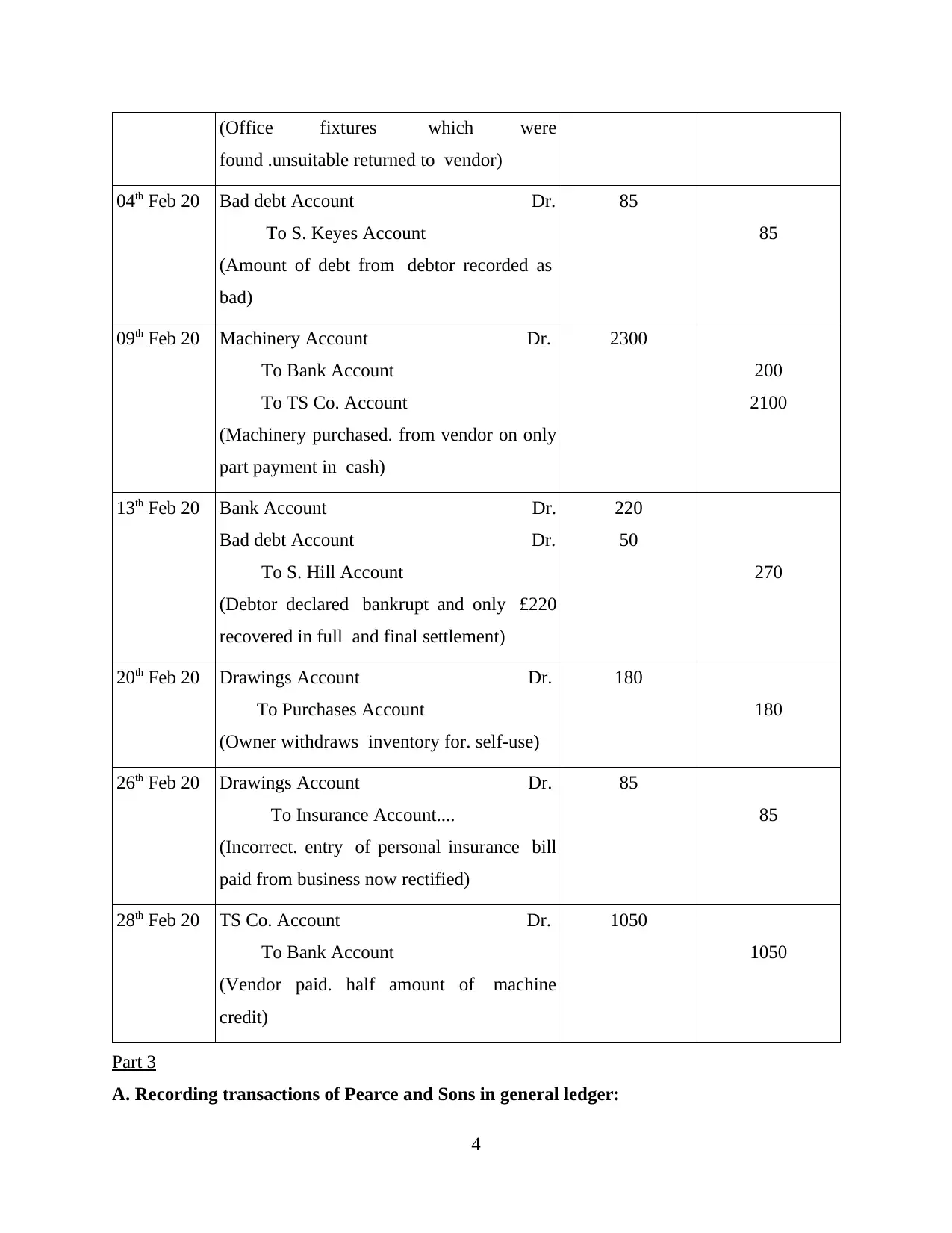
(Office fixtures. which were
found .unsuitable returned to .vendor)
04th Feb 20 Bad debt Account___________________Dr.
To S. Keyes Account.....
(Amount of debt from. debtor recorded as.
bad)
85
85
09th Feb 20 Machinery Account_________________Dr.
To Bank Account..
To TS Co. Account..
(Machinery purchased. from vendor on only
part payment in. cash)
2300
200
2100
13th Feb 20 Bank Account______________________Dr.
Bad debt Account___________________Dr.
To S. Hill Account...
(Debtor declared. bankrupt and only. £220
recovered in full .and final settlement)
220
50
270
20th Feb 20 Drawings Account__________________Dr.
To Purchases Account...
(Owner withdraws. inventory for. self-use)
180
180
26th Feb 20 Drawings Account__________________Dr.
To Insurance Account....
(Incorrect. entry .of personal insurance. bill
paid from business now rectified)
85
85
28th Feb 20 TS Co. Account____________________Dr.
To Bank Account....
(Vendor paid. half amount of. machine
credit)
1050
1050
Part 3
A. Recording transactions of Pearce and Sons in general ledger:
4
found .unsuitable returned to .vendor)
04th Feb 20 Bad debt Account___________________Dr.
To S. Keyes Account.....
(Amount of debt from. debtor recorded as.
bad)
85
85
09th Feb 20 Machinery Account_________________Dr.
To Bank Account..
To TS Co. Account..
(Machinery purchased. from vendor on only
part payment in. cash)
2300
200
2100
13th Feb 20 Bank Account______________________Dr.
Bad debt Account___________________Dr.
To S. Hill Account...
(Debtor declared. bankrupt and only. £220
recovered in full .and final settlement)
220
50
270
20th Feb 20 Drawings Account__________________Dr.
To Purchases Account...
(Owner withdraws. inventory for. self-use)
180
180
26th Feb 20 Drawings Account__________________Dr.
To Insurance Account....
(Incorrect. entry .of personal insurance. bill
paid from business now rectified)
85
85
28th Feb 20 TS Co. Account____________________Dr.
To Bank Account....
(Vendor paid. half amount of. machine
credit)
1050
1050
Part 3
A. Recording transactions of Pearce and Sons in general ledger:
4
⊘ This is a preview!⊘
Do you want full access?
Subscribe today to unlock all pages.

Trusted by 1+ million students worldwide
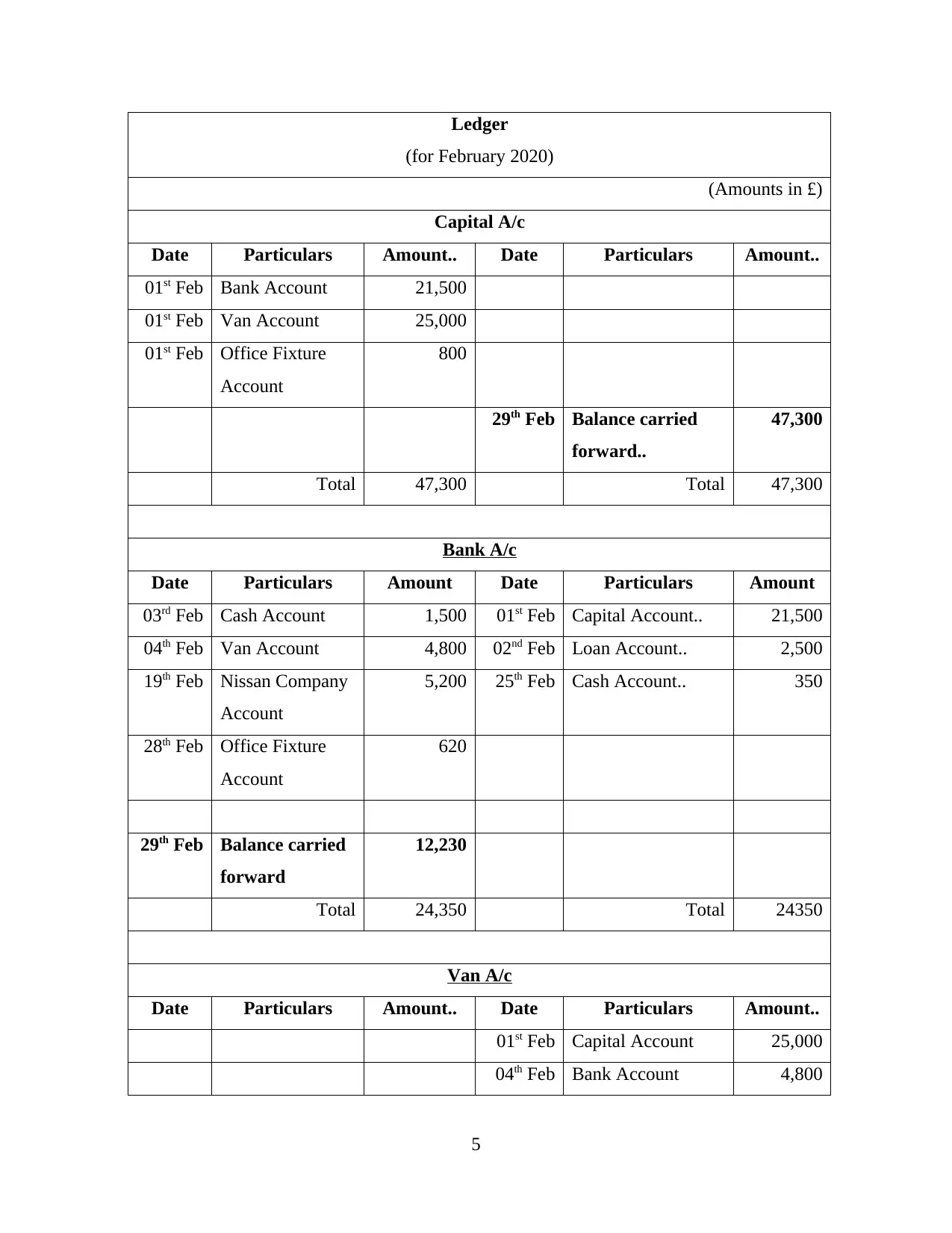
Ledger
(for February 2020)
(Amounts in £)
Capital A/c
Date Particulars Amount.. Date Particulars Amount..
01st Feb Bank Account.. 21,500
01st Feb Van Account.. 25,000
01st Feb Office Fixture..
Account..
800
29th Feb Balance carried
forward..
47,300
Total 47,300 Total 47,300
Bank A/c
Date Particulars Amount Date Particulars Amount
03rd Feb Cash Account.. 1,500 01st Feb Capital Account.. 21,500
04th Feb Van Account.. 4,800 02nd Feb Loan Account.. 2,500
19th Feb Nissan Company
Account..
5,200 25th Feb Cash Account.. 350
28th Feb Office Fixture
Account..
620
29th Feb Balance carried
forward..
12,230
Total 24,350 Total 24350
Van A/c
Date Particulars Amount.. Date Particulars Amount..
01st Feb Capital Account.. 25,000
04th Feb Bank Account.. 4,800
5
(for February 2020)
(Amounts in £)
Capital A/c
Date Particulars Amount.. Date Particulars Amount..
01st Feb Bank Account.. 21,500
01st Feb Van Account.. 25,000
01st Feb Office Fixture..
Account..
800
29th Feb Balance carried
forward..
47,300
Total 47,300 Total 47,300
Bank A/c
Date Particulars Amount Date Particulars Amount
03rd Feb Cash Account.. 1,500 01st Feb Capital Account.. 21,500
04th Feb Van Account.. 4,800 02nd Feb Loan Account.. 2,500
19th Feb Nissan Company
Account..
5,200 25th Feb Cash Account.. 350
28th Feb Office Fixture
Account..
620
29th Feb Balance carried
forward..
12,230
Total 24,350 Total 24350
Van A/c
Date Particulars Amount.. Date Particulars Amount..
01st Feb Capital Account.. 25,000
04th Feb Bank Account.. 4,800
5
Paraphrase This Document
Need a fresh take? Get an instant paraphrase of this document with our AI Paraphraser
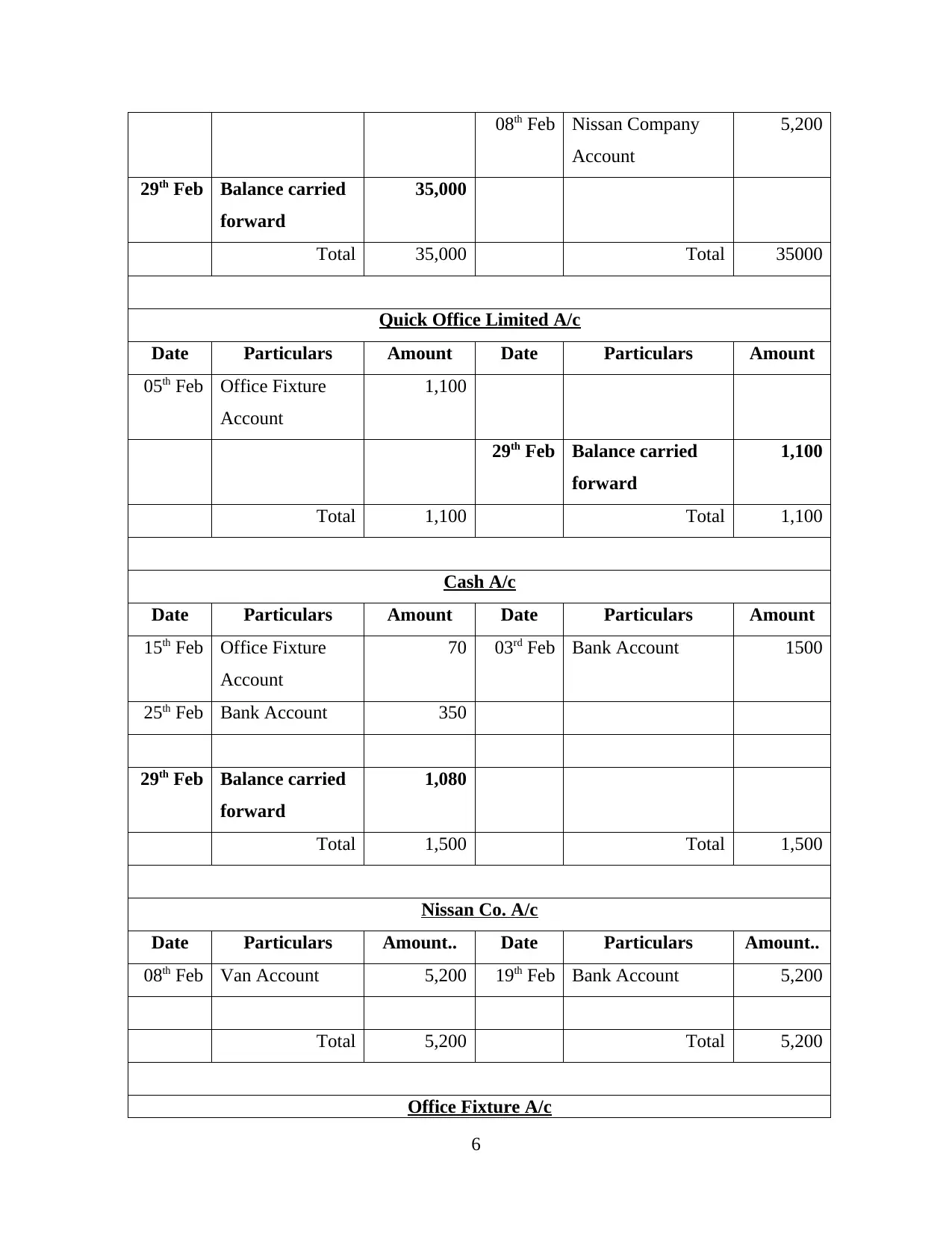
08th Feb Nissan Company
Account..
5,200
29th Feb Balance carried
forward..
35,000
Total 35,000 Total 35000
Quick Office Limited A/c
Date Particulars Amount Date Particulars Amount
05th Feb Office Fixture
Account..
1,100
29th Feb Balance carried
forward..
1,100
Total 1,100 Total 1,100
Cash A/c
Date Particulars Amount Date Particulars Amount
15th Feb Office Fixture
Account..
70 03rd Feb Bank Account.. 1500
25th Feb Bank Account.. 350
29th Feb Balance carried
forward..
1,080
Total 1,500 Total 1,500
Nissan Co. A/c
Date Particulars Amount.. Date Particulars Amount..
08th Feb Van Account.. 5,200 19th Feb Bank Account.. 5,200
Total 5,200 Total 5,200
Office Fixture A/c
6
Account..
5,200
29th Feb Balance carried
forward..
35,000
Total 35,000 Total 35000
Quick Office Limited A/c
Date Particulars Amount Date Particulars Amount
05th Feb Office Fixture
Account..
1,100
29th Feb Balance carried
forward..
1,100
Total 1,100 Total 1,100
Cash A/c
Date Particulars Amount Date Particulars Amount
15th Feb Office Fixture
Account..
70 03rd Feb Bank Account.. 1500
25th Feb Bank Account.. 350
29th Feb Balance carried
forward..
1,080
Total 1,500 Total 1,500
Nissan Co. A/c
Date Particulars Amount.. Date Particulars Amount..
08th Feb Van Account.. 5,200 19th Feb Bank Account.. 5,200
Total 5,200 Total 5,200
Office Fixture A/c
6
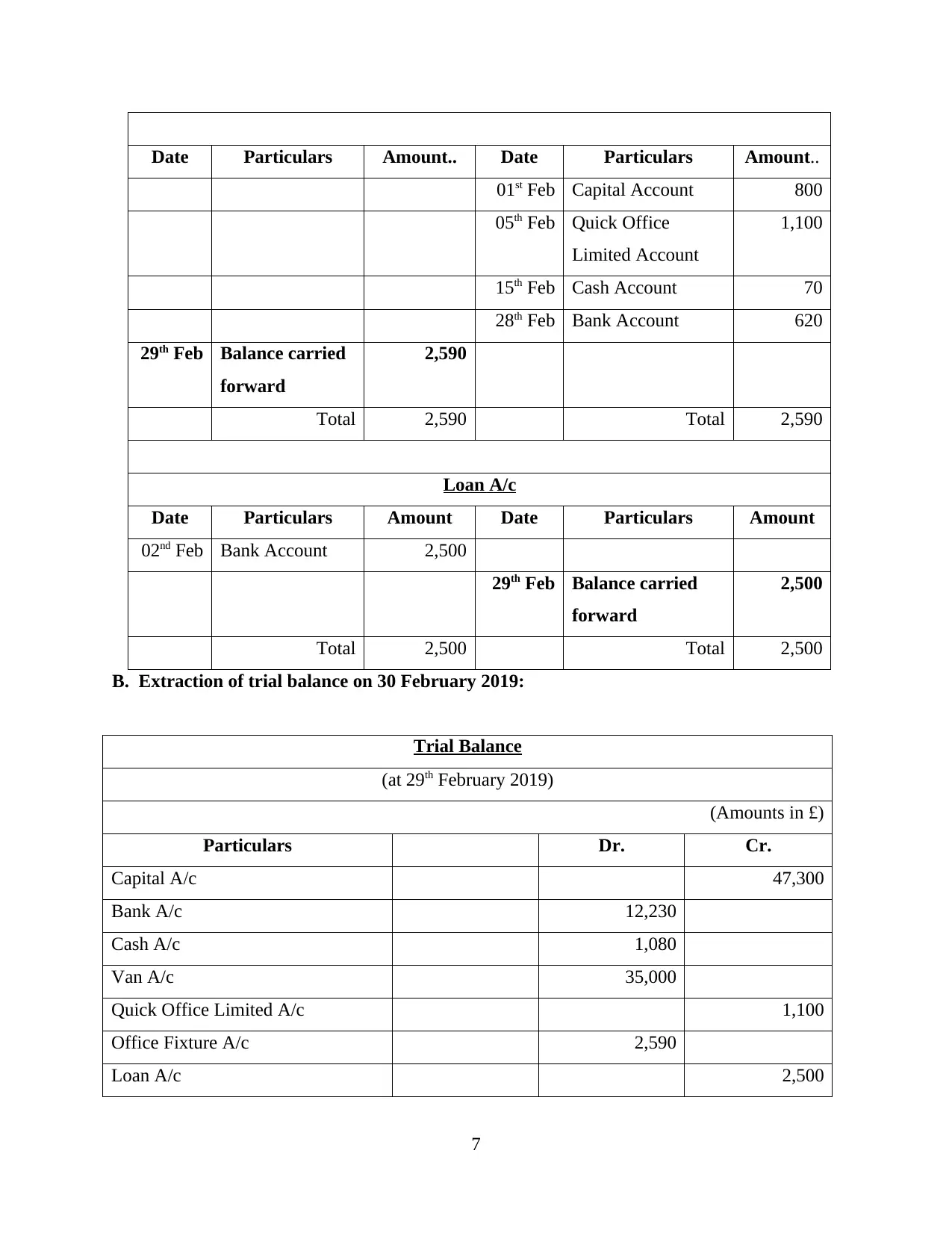
Date Particulars Amount.. Date Particulars Amount..
01st Feb Capital Account.. 800
05th Feb Quick Office
Limited Account..
1,100
15th Feb Cash Account.. 70
28th Feb Bank Account.. 620
29th Feb Balance carried
forward..
2,590
Total 2,590 Total 2,590
Loan A/c
Date Particulars Amount Date Particulars Amount
02nd Feb Bank Account.. 2,500
29th Feb Balance carried
forward..
2,500
Total 2,500 Total 2,500
B. Extraction of trial balance on 30 February 2019:
Trial Balance
(at 29th February 2019)
(Amounts in £)
Particulars Dr. Cr.
Capital A/c…. 47,300
Bank A/c…. 12,230
Cash A/c…. 1,080
Van A/c…. 35,000
Quick Office Limited A/c…. 1,100
Office Fixture A/c…. 2,590
Loan A/c…. 2,500
7
01st Feb Capital Account.. 800
05th Feb Quick Office
Limited Account..
1,100
15th Feb Cash Account.. 70
28th Feb Bank Account.. 620
29th Feb Balance carried
forward..
2,590
Total 2,590 Total 2,590
Loan A/c
Date Particulars Amount Date Particulars Amount
02nd Feb Bank Account.. 2,500
29th Feb Balance carried
forward..
2,500
Total 2,500 Total 2,500
B. Extraction of trial balance on 30 February 2019:
Trial Balance
(at 29th February 2019)
(Amounts in £)
Particulars Dr. Cr.
Capital A/c…. 47,300
Bank A/c…. 12,230
Cash A/c…. 1,080
Van A/c…. 35,000
Quick Office Limited A/c…. 1,100
Office Fixture A/c…. 2,590
Loan A/c…. 2,500
7
⊘ This is a preview!⊘
Do you want full access?
Subscribe today to unlock all pages.

Trusted by 1+ million students worldwide
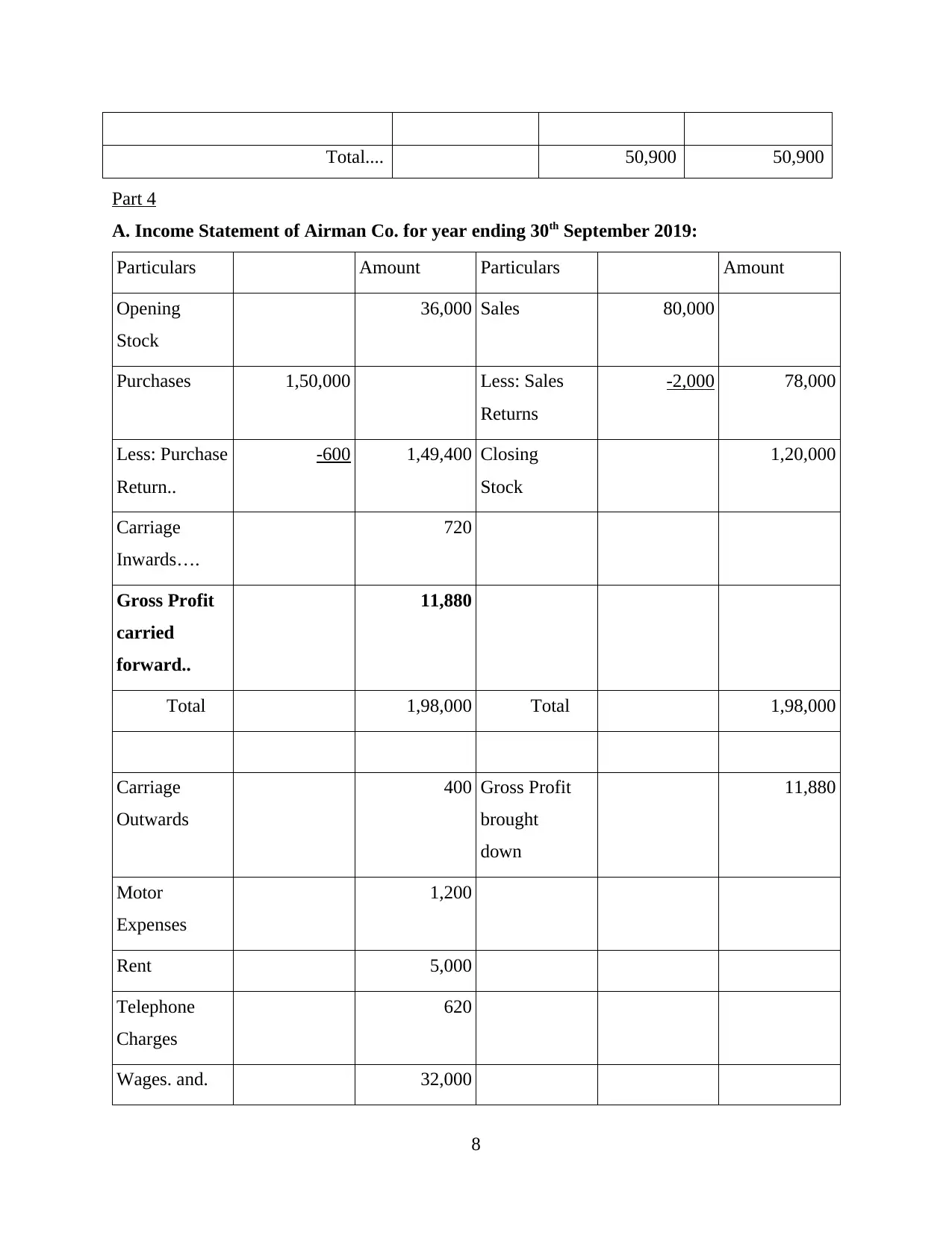
Total.... 50,900 50,900
Part 4
A. Income Statement of Airman Co. for year ending 30th September 2019:
Particulars Amount Particulars Amount
Opening
Stock….
36,000 Sales…. 80,000
Purchases…. 1,50,000 Less: Sales
Returns..
-2,000 78,000
Less: Purchase
Return..
-600 1,49,400 Closing
Stock….
1,20,000
Carriage
Inwards….
720
Gross Profit
carried
forward..
11,880
Total…. 1,98,000 Total…. 1,98,000
Carriage
Outwards….
400 Gross Profit
brought
down..
11,880
Motor
Expenses….
1,200
Rent…. 5,000
Telephone
Charges….
620
Wages. and. 32,000
8
Part 4
A. Income Statement of Airman Co. for year ending 30th September 2019:
Particulars Amount Particulars Amount
Opening
Stock….
36,000 Sales…. 80,000
Purchases…. 1,50,000 Less: Sales
Returns..
-2,000 78,000
Less: Purchase
Return..
-600 1,49,400 Closing
Stock….
1,20,000
Carriage
Inwards….
720
Gross Profit
carried
forward..
11,880
Total…. 1,98,000 Total…. 1,98,000
Carriage
Outwards….
400 Gross Profit
brought
down..
11,880
Motor
Expenses….
1,200
Rent…. 5,000
Telephone
Charges….
620
Wages. and. 32,000
8
Paraphrase This Document
Need a fresh take? Get an instant paraphrase of this document with our AI Paraphraser
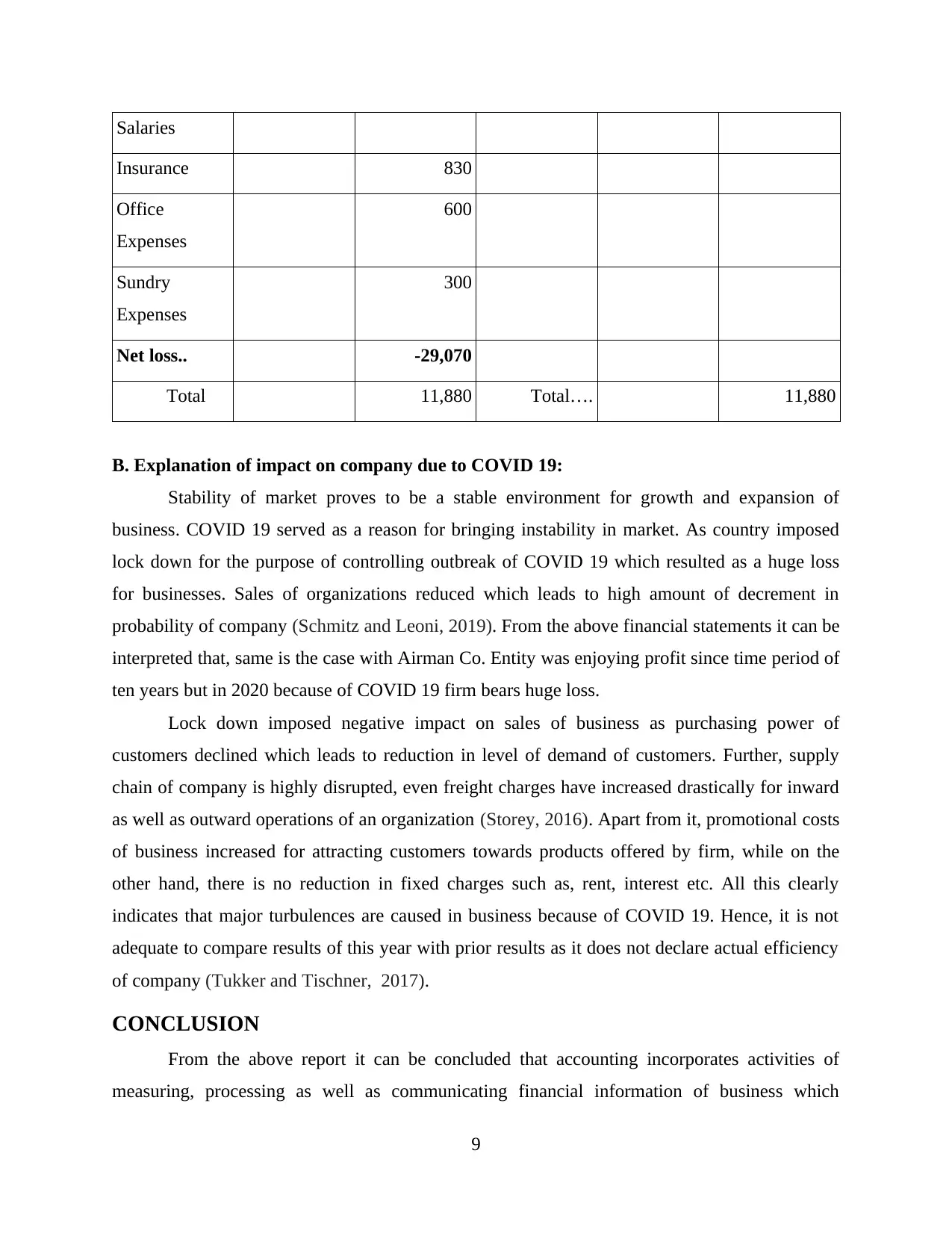
Salaries….
Insurance… 830
Office
Expenses….
600
Sundry
Expenses….
300
Net loss.. -29,070
Total…. 11,880 Total…. 11,880
B. Explanation of impact on company due to COVID 19:
Stability of market proves to be a stable environment for growth and expansion of
business. COVID 19 served as a reason for bringing instability in market. As country imposed
lock down for the purpose of controlling outbreak of COVID 19 which resulted as a huge loss
for businesses. Sales of organizations reduced which leads to high amount of decrement in
probability of company (Schmitz and Leoni, 2019). From the above financial statements it can be
interpreted that, same is the case with Airman Co. Entity was enjoying profit since time period of
ten years but in 2020 because of COVID 19 firm bears huge loss.
Lock down imposed negative impact on sales of business as purchasing power of
customers declined which leads to reduction in level of demand of customers. Further, supply
chain of company is highly disrupted, even freight charges have increased drastically for inward
as well as outward operations of an organization (Storey, 2016). Apart from it, promotional costs
of business increased for attracting customers towards products offered by firm, while on the
other hand, there is no reduction in fixed charges such as, rent, interest etc. All this clearly
indicates that major turbulences are caused in business because of COVID 19. Hence, it is not
adequate to compare results of this year with prior results as it does not declare actual efficiency
of company (Tukker and Tischner, 2017).
CONCLUSION
From the above report it can be concluded that accounting incorporates activities of
measuring, processing as well as communicating financial information of business which
9
Insurance… 830
Office
Expenses….
600
Sundry
Expenses….
300
Net loss.. -29,070
Total…. 11,880 Total…. 11,880
B. Explanation of impact on company due to COVID 19:
Stability of market proves to be a stable environment for growth and expansion of
business. COVID 19 served as a reason for bringing instability in market. As country imposed
lock down for the purpose of controlling outbreak of COVID 19 which resulted as a huge loss
for businesses. Sales of organizations reduced which leads to high amount of decrement in
probability of company (Schmitz and Leoni, 2019). From the above financial statements it can be
interpreted that, same is the case with Airman Co. Entity was enjoying profit since time period of
ten years but in 2020 because of COVID 19 firm bears huge loss.
Lock down imposed negative impact on sales of business as purchasing power of
customers declined which leads to reduction in level of demand of customers. Further, supply
chain of company is highly disrupted, even freight charges have increased drastically for inward
as well as outward operations of an organization (Storey, 2016). Apart from it, promotional costs
of business increased for attracting customers towards products offered by firm, while on the
other hand, there is no reduction in fixed charges such as, rent, interest etc. All this clearly
indicates that major turbulences are caused in business because of COVID 19. Hence, it is not
adequate to compare results of this year with prior results as it does not declare actual efficiency
of company (Tukker and Tischner, 2017).
CONCLUSION
From the above report it can be concluded that accounting incorporates activities of
measuring, processing as well as communicating financial information of business which
9
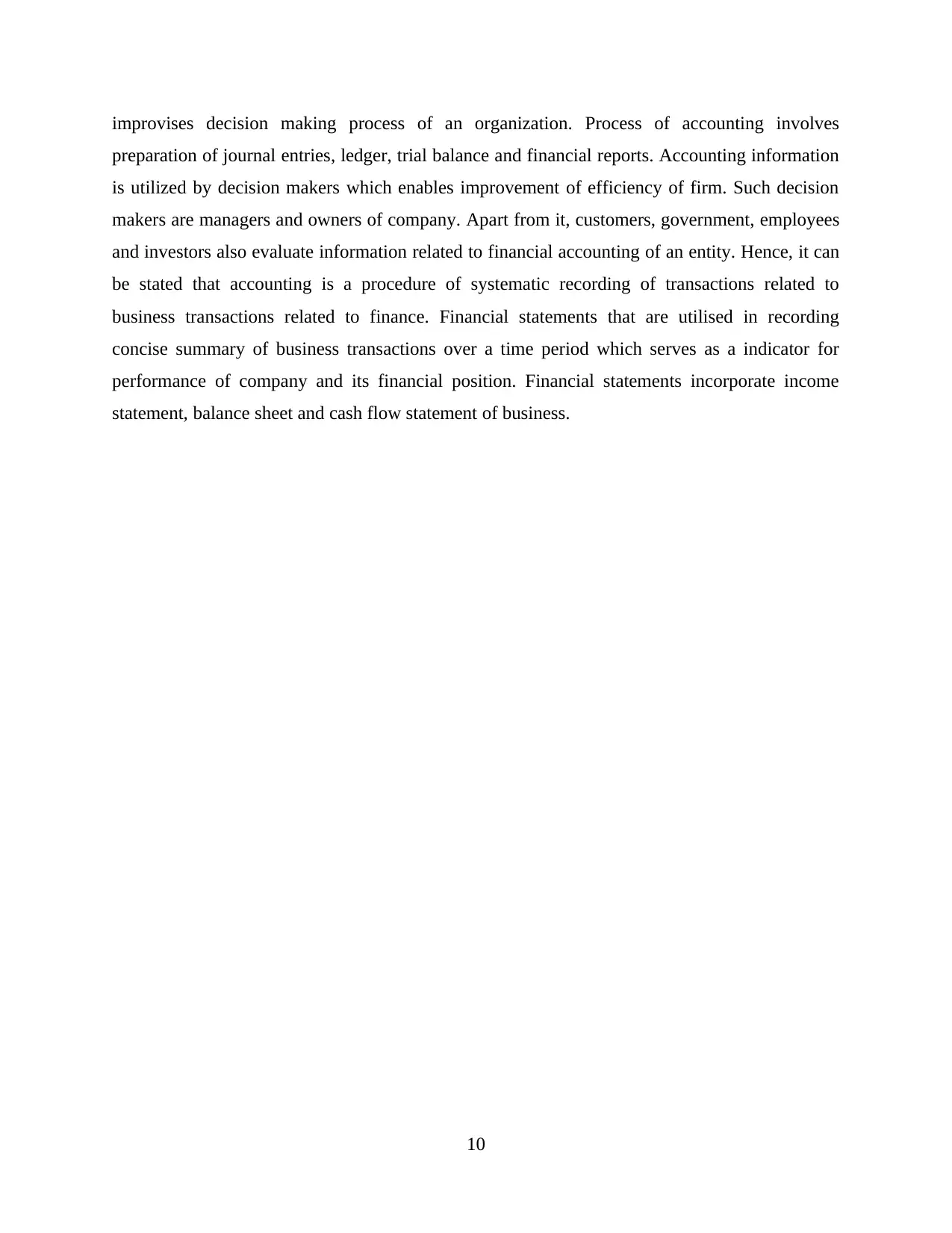
improvises decision making process of an organization. Process of accounting involves
preparation of journal entries, ledger, trial balance and financial reports. Accounting information
is utilized by decision makers which enables improvement of efficiency of firm. Such decision
makers are managers and owners of company. Apart from it, customers, government, employees
and investors also evaluate information related to financial accounting of an entity. Hence, it can
be stated that accounting is a procedure of systematic recording of transactions related to
business transactions related to finance. Financial statements that are utilised in recording
concise summary of business transactions over a time period which serves as a indicator for
performance of company and its financial position. Financial statements incorporate income
statement, balance sheet and cash flow statement of business.
10
preparation of journal entries, ledger, trial balance and financial reports. Accounting information
is utilized by decision makers which enables improvement of efficiency of firm. Such decision
makers are managers and owners of company. Apart from it, customers, government, employees
and investors also evaluate information related to financial accounting of an entity. Hence, it can
be stated that accounting is a procedure of systematic recording of transactions related to
business transactions related to finance. Financial statements that are utilised in recording
concise summary of business transactions over a time period which serves as a indicator for
performance of company and its financial position. Financial statements incorporate income
statement, balance sheet and cash flow statement of business.
10
⊘ This is a preview!⊘
Do you want full access?
Subscribe today to unlock all pages.

Trusted by 1+ million students worldwide
1 out of 13
Related Documents
Your All-in-One AI-Powered Toolkit for Academic Success.
+13062052269
info@desklib.com
Available 24*7 on WhatsApp / Email
![[object Object]](/_next/static/media/star-bottom.7253800d.svg)
Unlock your academic potential
Copyright © 2020–2025 A2Z Services. All Rights Reserved. Developed and managed by ZUCOL.




